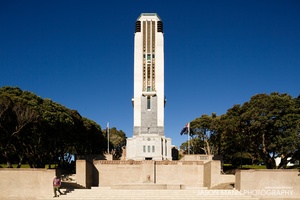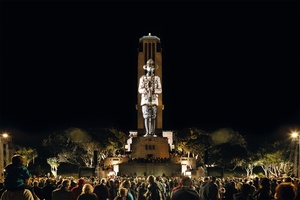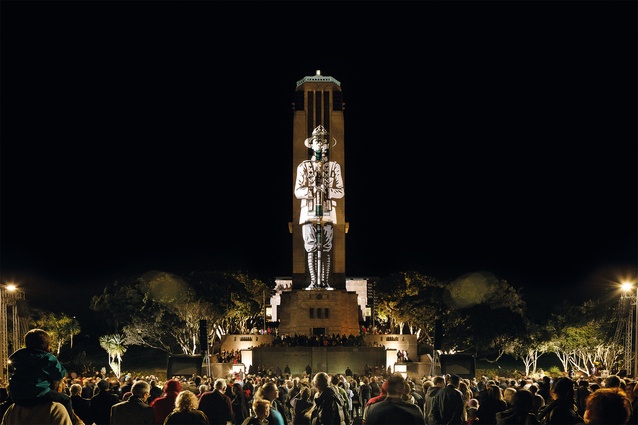Opinion: Guy Marriage
The redevelopment of New Zealand’s National War Memorial Park in Wellington has been lengthy and controversial. Here, Guy Marriage offers up his thoughts about the process and the outcome.

Wellington’s newest park is for all of Aotearoa, commemorating those that have fought for and fought over our country. In pre-European times, Pukeahu was a Māori stronghold: a large natural fortress of rock and clay with a fine view of the harbour. Māori ownership was whittled away bit by bit; as Wellington was settled, the hill (now dubbed Mount Cook) was taken and the top nibbled away.
At first, a gaol was built, brooding over the city but, soon, this was overtaken as a large imposing brick barracks and, thus, for years, the hillside has had military overtones; HMNZS Olphert (1941), the Defence Stores Office (1911) and the old brick Mount Cook Police Station (1894) dot the edges of the site, even today.
Catholic and secular educational buildings surround the site, with St Patrick’s formerly nearby, along with a sole religious remnant: the Home of Compassion Crèche (1914). The National War Memorial Carillon (1932), the Hall of Memories (1964) and the Tomb of the Unknown Warrior (2004) now form the centrepiece of the park, backed up by the stone bulk of the National Art Gallery and Dominion Museum (1936), since occupied and recently partially vacated by Massey University for a four-year-long, Sir Peter Jackson-designed exhibition.
The remaining Māori-owned land makes up a thin slither of its former self – but a significant one – as the holding place of our sacred military memories. Gummer and Ford’s original design placed the National War Memorial at the head of a park reaching out towards the harbour but, instead of a scenic vista, there was a slum of cramped, low-cost housing for migrant workers, later supplanted by motley rows of industrial sheds and service stations. Not such a grand vista after all.
The simple concept, originally proposed by Helen Clark’s government, was to expand the park by buying up properties on the other side of the street and moving the roadway north. Sites were bought up and shedifices demolished. A tentative concept plan was produced, with the road swooping out away from the Carillon towards the harbour and then back to Taranaki Street in a single, simple curve. Plenty of time to install that by April 2015: a decade to plan.
But, in an adroit political move, the tiny Mount Cook School protested about the extra fumes likely to be pumped into the tiny lungs of tiny schoolchildren, and paralysis descended over the entire project for a very long age. No Labour government wants to be seen to be honouring the war dead by poisoning little children; neither does a National one. The project stalled and the land sat empty.
To cut a long story short, a competition was held, which the Wraight/Athfield team won. All of the schemes submitted had the road, State Highway 1 (motorway in all but name), running through the War Memorial Park at ground level and meeting the tail end of the proposed Basin Reserve flyover. The Architectural Centre and Richard Reid & Associates lobbied for a tunnel to run below Tory Street and the park but, seemingly, to no avail.

This was immensely disappointing to many, as the rise of the hill seemed to indicate that a far better park would be gained by a tunnel running beneath the landscape, but what seemed like such an obviously good idea was denied by the Ministry for Culture and Heritage on the grounds of cost. Then, mid-project, in the blink of an eye, years of careful, ground-based design work was undone and a new route was to be carved out; the highway was to be placed underground below the park after all. Grade separation gave one fewer intersections for traffic to cope with: Tory Street would sail over Buckle Street.
Curiously, for a cultural project of such importance, both park and roading were to be built by New Zealand Transport Authority (NZTA). Flyover heights were massaged carefully to accommodate a new landing point. The historic Home of Compassion Crèche was restored, base isolated, and shunted sideways, backwards and upwards in a legally rather dodgy manner, during the Basin Bridge enquiry, although it still has no real function. The budget was changed quietly to accommodate a tunnel, separate from the park above, and then broadly glossed over.
Don’t ask the price. How can you put a price on peace, nationhood and national significance? Let’s pretend it’s all fine. This project, always, was going to be about a deadline – the immoveable holy deadline of 25 April 2015, exactly 100 years since our allegedly ‘nation-forming’ days of destruction at Gallipoli. Given that such a well-known date was identified more than 10 years ago, it is amazing that the project was done eventually in an unholy rush, in less than two years. Special legislation had to be passed under urgency, claiming that this project was so special that resource consent and other such trivialities would be dispensed with, and we would just have to trust that it would all be done alright by those in charge.
Amazingly, National, Labour, Greens, New Zealand First – all the parties – agreed that, while this should not set any precedents, on just this one occasion we could trust the NZTA to get it right. Of course, this begs the question as to whether we should even have to bother with the charade of resource consent applications on an everyday basis – just hire a competent team of people, throw money at it and we’ll do the job properly. As time and quality were controlled so tightly, the cost must have gone skyward.
The construction alliance kept a tight rein over the project, however, and the project was completed a month early; the contractors are still itching to build the flyover next. I’m still hoping that they don’t. The end result is, undoubtedly, a rich experience. We now have the joy of driving through the Arras Tunnel, which skims a mere few metres below the surface of the park but it may as well be a world away – no sound emanates from beneath our feet in the park above.

The approach to Massey University has been thoroughly tidied up, with a newer, almost subtle, entry and exit, no longer dominating the enlarged forecourt of the Carillon. Cars are banned almost completely; this is a place for people. The Carillon Tower itself has been seismically strengthened and the stonework and plasterwork restored while, in front of the steps up, we now have an impeccably maintained parade ground, with honed slabs of Chinese basalt set out with military precision. This looks out to the Australian Memorial, symbolically important as it represents our ANZAC cousin and resplendent in rich-red Indian sandstone laced with strips of carved black granite.
Inevitably, eucalypts grow between the pillars of stone – and, in time, they will be the focal point: a substitute for our truncated harbour view. Three mighty boulders edge the base of the hill, from Taranaki, Tongariro and Ruapehu, standing guard at Pukeahu. Two kauri and copper-clad winged structures provide shelter from the elements and create moments for reflection on the sacrifice of our forefathers. Walkways and slightly sculpted walls of charcoal-coloured concrete fan out from the centre, presenting a series of shallow ledges, perfect for summertime relaxing in the park. Shiny studs in the asphalt delineate the position of past archaeological remains.
I live nearby; this will be my new local park, as well as your national park. There are minor quibbles by some, of course. The sandstone wasn’t from Australia. The kerbs are too low, leading some cyclists to fall off, thinking they are flat. The poppies in the tunnel are too stylised, too round. Skateboarders continue to grind inappropriately on the edges, with no respect for the solemnity of the surroundings. The cut-outs for the tunnel approach limit the size of the park – on the two days a year they will close it off for commemorations.
But these quibbles miss the point altogether. What we have here, at long last, is a Memorial Park worthy of the name. Can you imagine it if the road had been permitted to go through at ground level? (For the benefit of Aucklanders, it would be like having the Southern motorway going through the Domain, right past the door of the Museum, and being closed to traffic twice a year).
Instead, we have a much-needed green space: an unshaded, unpolluted, high-quality urban landscape which, one day, will host a whole array of interesting new sculptural memorials commemorating the many nations with whom we have been to war or against whom we have fought. The Brits and the Americans will invade first, of course, and then, perhaps, we’ll have the French. But, then, surely also the Russians, Poles, Germans and, of course, Turks, Indians, Japanese, Italians, Chinese, Canadian, Vietnamese and Koreans.
Where are we going to fit in all of these memorials? We can’t say “good guys on one side and bad guys on the other” because those boundaries, increasingly, are blurred. Our former overlords are now sniffy about friendship. Our former enemies are now our biggest trading partners and, therefore, our friends.
There is no room for projected giant displays of ‘military might’ in our Pukeahu National War Memorial Park, as we don’t go in for that sort of thing: no giant crossed swords of Saddam nor the giant clenched fist of Gaddafi; and no heroic, bare-chested Russians pointing to the sky or to the motherland. Instead, we’re likely to see carefully reflective, subdued responses, thinking back to the futility of war. Perhaps, just perhaps, Pukeahu will become the first truly global monument to Peace.










